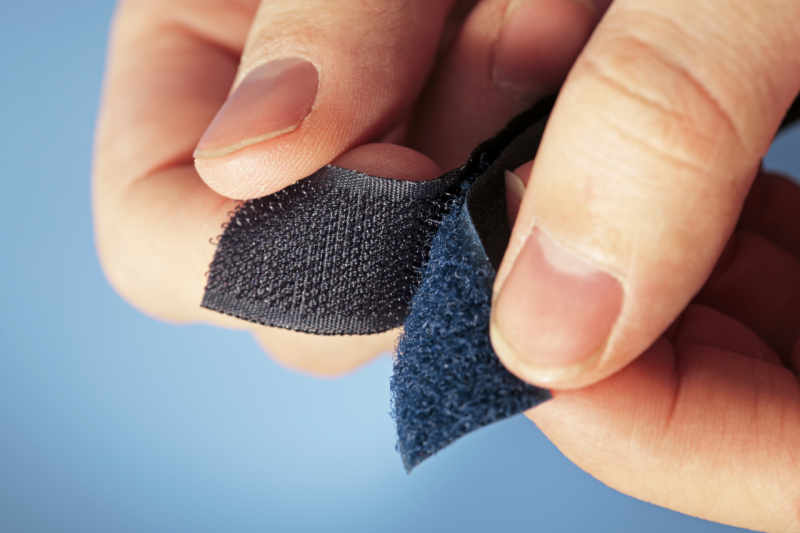Just seeing the word “Velcro” sets off a sound effect in your head: the sound of two sides of the sticky fabric pulling apart.
Velcro plays such a big part in our lives, and it has since it earned its patent in 1955. But what’s the story behind this scratchy, sticky, and very useful material—who invented Velcro and why?
Let’s dive in.
ADVERTISEMENT |
Who Invented Velcro?
The man who created Velcro had inventiveness in his blood—he filed for his first patent at the age of 12 for a toy plane he had created. But George de Mestral‘s biggest break would come nearly 40 years later when he patented his greatest invention of all: Velcro.
Between childhood and his invention, de Mestral worked hard so that he could study engineering and become a bona fide inventor. The Swiss native took on a slew of odd jobs to pay for his education at the Ecole Polytechnique Federale de Lausanne. And, after graduation, he took a job in an engineering company’s machine lab, which left him plenty of time to create on his own.
What Inspired de Mestral to Create Velcro?
Surprisingly enough, de Mestral didn’t come up with the idea for Velcro while working in the lab. He didn’t invent it while tinkering outside of working hours, either.
The idea came to him while he was on vacation in 1948. His two-week break brought him to the Jura Mountains, which run through Switzerland and France. There, he planned to do some bird hunting with his dog—an Irish hunter— by his side.
ADVERTISEMENT |
Once de Mestral and his dog made their way into the woods, though, they found more than just the hunt challenging them. Both man and dog were plagued by cocklebur plants, which dropped spiky seed pods that stuck to their clothes and fur, respectively.
de Mestral struggled to remove the spikes from his clothes and his dog’s fur. So, he held onto a few of the seed pods so that he could inspect them under a microscope and better understand how they worked.
When he magnified the exterior of the seed pod, he was surprised to find that the spikes were covered in hundreds of tiny little hooks. These extra-small, curved sickles allowed the cockleburs to attach so effectively to the fabric.
How Did de Mestral Invent Velcro?
Now, these little hooks gave de Mestral an idea: he wanted to mimic those same hooks to create a fabric fastener. So, he started by reaching out to cloth and fabric experts in France. Many of them told the inventor that his idea probably wouldn’t work.
This didn’t deter de Mestral, though. Instead, he started to weave his own hooks to create a fastener on his own. However, the loops he made were a bit too big to catch the hooks. Or, he made the hooks proved far too large to hold onto the loops.
ADVERTISEMENT |
Luckily, de Mestral eventually met a weaver who had an inventive side—he wanted to help create small-enough hooks and loops to make the vision a reality. With a small loom and working by hand, the weaver was able to create the loop-and-hook pattern in cotton fabric. When both of the sides were pressed together, they clung to one another, just as the cockleburs stuck to de Mestral’s pants.
Eventually, the inventor found that cotton wasn’t the best fabric for his project. He discovered that nylon that he sewed under infrared light made the loops and hooks nearly indestructible. And that’s the version of Velcro that was at the center of his patent request.
What Happened After He Perfected Velcro?
As we said, de Mestral had to apply for a patent for his incredible creation. But the product needed a name.
ADVERTISEMENT |
He combined the French words “velours,” which means velvet, and “crochet,” which means hook for the perfect portmanteau: Velcro. He earned a Swiss patent in 1955, and countries across the world—Canada, Italy, Belgium, Sweden, France, the US, and more—followed suit.
By this time, de Mestral had left his day job to work on Velcro full-time. He eventually invented the machine that could create the hook-and-loop system so that the material could be mass-produced.
It may come as a surprise, but Velcro wasn’t an overnight success. It started to roll out in the 1960s, and industries—and consumers—were slow to pick it up.
ADVERTISEMENT |
But soon enough, the aerospace industry adopted Velcro since it made it very easy to take heavy, bulky spacesuits on and off. Then, parents realized that Velcro made it easy for them to take their kids’ shoes on and off. From there, it took off, and people found it everywhere from military apparatuses to Velcro sandals to the small Velcro cable straps you use to keep your home organized.
By that time, Velcro was as big of a success as de Mestral had imagined it would be. He was producing more than 60 million yards of the fabric a year before he died a multi-millionaire in 1990.
The Legacy of Velcro
Even after de Mestral’s death, Velcro remains an important resource for other creators. From fashion to engineering to medicine and more, industries have adopted Velcro for its ease of use, durability, and strength.
ADVERTISEMENT |
And Velcro is a great example of how nature can inspire invention, too. de Mestral studied how the cocklebur had evolved to stick so well to his clothes and used his findings to create a manmade version.
So now you know who invented Velcro—and it’s truly an amazing tale. Check back with our sites for equally as incredible stories about business, tech, politics, tourism, and more.






